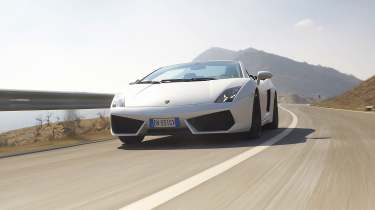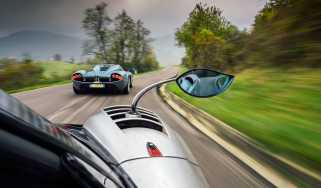Lamborghini LP560-4 Spyder
Lamborghini has taken the roof off its 552bhp Gallardo to create this, the LP560-4 Spyder. It’s just as stunning to look at, but is it still as good to drive?
Roof down, air hovering around five degrees, a whispy band of mist gently dispersing into the bluing sky and, most importantly, the heated seat turned up to six. We’re skimming low to the ground, crossing the flat and open countryside heading south from Sant’Agata. There’s something comforting about the sensation of warmth seeping through to your back and hamstrings in a convertible; it’s like sitting on one of those big old-fashioned radiators you used to find in cold classrooms and draughty church halls.
The LP560-4 has been turned from a wedge to a sliver of Italian automotive sculpture. It looks absolutely stunning, of that there is no question. But de-roofing divides people. Some hate it because they see it as emasculating a wonderful car. They say it’s a process that reduces rigidity, then adds weight trying to get that rigidity back. They see something like a Gallardo Spyder as a compromise, a hash up, a faint shadow of what the car was designed to be.
And then there are those who love cars like this. They, I suspect, fall into two categories. The first lot want to pose and be looked at. They want to bathe conspicuously in the reflected glory that the car gathers around it (failing to realise that people are interested in the car, not the person driving it. Plus you only really look cool in a convertible if you live in a country with a climate that complements it). The second reason for buying a drop-top is because you want to be that little bit closer to the world you’re driving through. You want to hear the changes in the tarmac you’re covering, feel the reverberating exhaust note, catch the smell of the brakes as you haul off speed into a hairpin. But if that’s why you want a convertible then you’ll want one that hasn’t been compromised, hasn’t been produced purely for people in the first category. So what is the LP560-4 Spyder? Drivers’ car or poseurs’ carriage?
More reviews
Reviews
- Lamborghini Gallardo (2003 - 2013) review – the baby V10 supercar that saved the company
- Lamborghini Gallardo Squadra Corse review
- 2013 Lamborghini Gallardo LP560-4 review
- Lamborghini Gallardo LP570-4 Spyder Performante review
- Lamborghini Gallardo LP570-4 Superleggera review
- Lamborghini LP570-4 Superleggera review
- Lamborghini LP550-2 Balboni
- Lamborghini Gallardo LP560-4
Well, whether you want to or not, you’ll attract attention. We slow down to 50kph and the almost impossibly luxurious paintwork of the Gallardo glides through a village. I might be tucked up behind the collar of my coat and the shallow rake of the windscreen, but I can feel every gaze that falls on the car. Stop at traffic lights and the people walking along the pavement might as well be in the passenger seat fiddling with the toggle switches. Exposed by the lack of roof you suddenly seem to be that much more accountable too, you feel more compelled to let people out of side turnings, and it seems like a personal affront if you get cut up on a roundabout.
Hold second gear on the long, curling slip road away from the toll booth. A white dotted line appears to the left as the road straightens. Check the wing-mirror for a gap then slam forward onto the autostrada, engine note ricocheting off the side of a lorry. With the roof down but the windows up (including the rear one, which acts like a wind deflector when the hood’s down), buffeting is minimal, but there is a cold stream eddying its way down to the handbrake and gently freezing my right hip.
It could be distracting, but frankly I’m more concerned with making the most of the multiple tunnels we’re going through. The last time I was out this way I was able to wind the windows down on a Scuderia, which was pretty spectacular, but having a Lamborghini V10 behind and an uninhibited view of the barrelled stone ceiling above makes for nothing less than orchestral ecstasy. The noise seems to spill from the exhaust, bounce off the tunnel walls and then tumble all around you so that you feel as if you’re actually inside the sound. It’s like standing where the conductor does at a concert rather than perching in row K, seat 11.
Soon our exit appears and we turn onto smaller and altogether less smooth roads. In places the tarmac looks as though it has melted and then suddenly re-hardened, leaving a surface as rough as any I’ve seen, yet the Spyder remains resolute, the scuttle never shimmying and the damping soaking up the choppy tarmac with aplomb.
We’re climbing now, well above any remaining mist hanging about in the valley below. It seems to get lighter and lighter as the road twists ever skywards, the road and countryside looking almost bleached in the glare of the sun, the pearlesence of the Gallardo sparkling as the rays dance on its surface. Then darkness.
The arrival of big, brooding evergreens on either side is like the point in a film when a hero suddenly becomes outnumbered by his nemesis’s henchmen closing in around. The road changes character too, straightening and allowing the Gallardo to stretch its legs, sweeping into corners without the need for even a lift of the throttle. Look up and there’s still a narrow strip of blue high above, but there’s a sense that you want to press on with speed until that strip blossoms into an overarching dome once more.
The Gallardo always feels like a dense car to drive (unlike the Murciélago, strangely) and seems to be constantly exerting pressure on your body. You accelerate and there’s an instant and heavy shove from behind, then you change direction and the weight of the steering requires effort from your forearms and the immense lateral grip from the chassis and P Zero Corsas makes the seat’s side bolsters lean weightily on your torso. As we burst out of the trees there’s a section of endless left-rights that need short stabs of acceleration, then dabs of brake. Combined with the constant direction changes, the occasional positive camber that pushes you down into your seat and the bark of ten cylinders, it’s a very physical experience.
You might have guessed by now where we’ve been heading. The Futa and Raticosa were the last mountain passes in the Mille Miglia before the final charge over the plains of the Emilia-Romagna to Brescia. They’ve been used many times in evo shoots, but I’ve never been here before and it’s a huge thrill to be driving these historic bends. It’s midweek and there’s only the occasional car to get in the way. We have a chat with two smiling policemen in a Bravo who conform to type with the ‘Shall we swap cars?’ joke before leaving us alone up on the ridge.
Whilst I’m daydreaming about the Mille Miglia, something crosses my mind (not a long journey). We tend to think that sports cars without roofs should be small and light and that the biggest engine you should shoehorn in is a six-cylinder. But some of the greatest and most desirable sports cars of all time, cars like the Moss/Jenks Mercedes Benz SLR of ’55 and the Collins/Klemantaski Ferrari 335 S of ’57, were relatively big cars with hulking great engines. And how much more romantic and exciting were they for exposing their pilots to the elements as they roared over these passes? In many ways, something like the Gallardo Spyder seems to be the modern equivalent.
With four-wheel drive (split 30-70 front-to-rear by a viscous coupling) and a mechanical limited-slip differential on the rear axle, you might wonder how much work a crowd would see the driver of an LP560 doing. Surely it would be all maximum grip and no slip? Well, not entirely. The suspension on the Spyder feels just slightly softer than the coupe’s and when it’s loaded up in a corner you have to balance all the inputs neatly to avoid upsetting it. Change gear when the chassis is working hard on the exit of a long corner, for example, and you can feel the car shift underneath you, squirming as the transmission unloads and loads. Turn into a bend hard on the brakes and you’d better be careful what your next move is, because the V10 behind you won’t hesitate to snap out of line if you provoke its momentum too much. There is ESP, of course, but it loosens appropriately depending on which shift mode you choose for the e-gear transmission (Normal, Sport or Corsa), and nevertheless the LP560 can feel intimidating for a while because although there’s masses of reassuring grip, this means the limits will be high if and when you breach them.
But work with the grip, subtly use little lifts of the throttle to tighten the line in the first part of the corner, then get on the power early and use the four-wheel drive to pull you towards the exit and the Gallardo is mesmerising. The 552bhp feels as strong and intoxicating as you’d imagine, simply hurling you up the road until your head feels light. All out, Lamborghini claims it will hit 201mph. I can well believe it.
In Corsa mode each e-gear change has a suitable amount of theatre about it, downchanges being executed with particularly decadent acoustic flourishes. Photographer Gus Gregory says that in these seemingly deserted mountains you can hear the Gallardo approaching from miles away, starting off as a small, intermittent cacophony as it dives in and out of corners and disappears momentarily behind hillsides, then gradually building to a crescendo as it howls up the road directly towards him and fills his camera’s viewfinder in a sudden rush.
I play for a couple of blissful hours, but all too soon our time on the Raticosa is up and we have to descend and return. Behind the new, optional black ‘Cordelia’ wheels of this car are the standard steel brake discs, the front ones clamped by eight-piston calipers. These brakes are much better than the optional carbon-ceramic items we’ve had on most of the Gallardos we’ve tried (and which, strangely, only have six-pot calipers on the front). They give more feel through the pedal – although it’s still not perfect — and don’t show any signs of wilting in a long and tight descent. As we wind our way back down the narrow and more populous roads towards the autostrada, I am also aware of just how easy it feels to place the Gallardo on the road, something that I’m sure is helped by the added spatial awareness afforded by the lack of roof.
As we roll back through the gates of Automobili Lamborghini and park up (half an hour late, but I don’t think the Italians can really give lectures on punctuality), I suddenly realise that I haven’t tested the roof. Hold the beautiful chromed toggle switch on the transmission tunnel and the whole carbonfibre rear deck slides up and back before a small black canvas tent unfurls and descends on you, attaching itself to the top of the windscreen with a whirr of electric motors. It’s very neat, much better than the Murciélago’s, but I quickly put it down again because being in a convertible supercar with the roof up feels about as awkward as answering the door in a shower cap.
And so to the car or carriage question. Well, the LP560-4 Spyder is slightly softer than the hard top, something I suspect you’d notice more on a trackday. But it is also still an unequivocally ruthless drivers’ car, plus you get all the theatre of feeling, seeing, smelling and hearing the world you’re travelling through, which I love. And if you’re worried about appearing to be a poseur, grow a beard, wear a hat and drive it on a mountain where no one can see you.
Specifications
| Engine | V10 |
| Location | Mid, longitudinal |
| Displacement | 5204cc |
| Cylinder block | Aluminium alloy, dry sumped |
| Cyiinder head | Aluminium alloy, dohc per bank, 4 valves per cyl, variable valve timing |
| Max power | 552bhp @ 5800rpm |
| Max torque | 398lb ft @ 6500rpm |
| Transmission | Automated sequential manual (option), four-wheel drive, rear limited-slip differential, ESP |
| Suspension | Double wishbones, coil springs, dampers, anti-roll bar front and rear |
| Brakes | Ventilated discs, 365mm front, 356mm rear, ABS, ABD |
| Wheels | 8.5 x 19in front, 11 x 19in rear, aluminium alloy |
| Tyres | 235/35 ZR19 front, 295/30 ZR19 rear, Pirelli P Zero |
| Weight (kerb) | 1550kg |
| Power-to-weight | 362bhp/ton |
| 0-62mph | 4.2sec (claimed) |
| Top speed | 201mph (claimed) |
| Basic price | c£160,000 (est) |
| evo rating | 4.5/5 |




